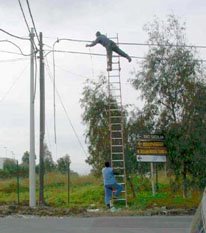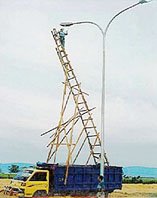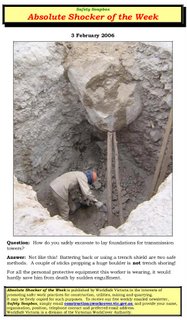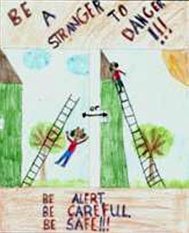This is Washington for you...
As everyone in the country (except possibly for Rip Van Winkle) probably knows, we will be facing a flu pandemic sooner or later, probably sooner. If/when that happens, we'll need a lot of healthy and knowledgeable health care workers to care for millions of critically ill patients. They need to be protected from getting the flu themselves, and one of the ways to protect them from inhaling the flu virus is to use effective respirators.
Happily, the relatively inexpensive N-95
disposable respirator will probably do the trick. They are used in both medical and industrial settings to prevent the inhalation of harmful microscopic particles.
Unfortunately, the N-95 at $1 to $3 a piece, is not quite cheap enough for health care institutions that will have to stock millions of them. And the Bush administration, not having learned its lesson in New Orleans that you can't deal with a major disaster on the cheap, is thinking about a couple of alternatives -- using surgical masks instead of respirators, or possibly re-using the disposable respirators. In fact, the current
Pandemic Influenza Plan, issued by the Department of Health and Human Services,
recommends the use of surgical masks instead of NIOSH certified respirators
So, the US Department of Health and Human Services requested that an Institute of Medicine committee study the potential reuse of N-95 disposable respirators and surgical masks in the event of an influenza pandemic.
Oy.
Now I don't know how much was spent on this study, but I'll bet I could beat the price.
Step 1: I Google the word "disposable."
disposable: Designed to be disposed of after use
There, that took about half a minute. So let's see, at the rate I
should be paid for being an Washington DC-based
award-winning blogger (let's say conservatively, in the neighborhood of $1000 an hour), that comes to a little over $8. Plus expenses, depreciation, office expenses, utilities, etc, etc., we'll round it off to $25.
But wait. If you've ever read a scientific research study, you'll know that they always end the same way: calling for more research. So, just to be sure, we'd better look up "disposed of" as well (doubling my fee to $50)
disposed of: To get rid of; throw out
OK, well I guess that just about settles it. My exhaustive investigation has concluded that:
Disposable respirators are meant to be thrown out, not re-used.
And sure enough, the Institute of Medicine came to precisely
the same conclusion (for a bit more money, I'm sure). To make a long story short, the committee could find no way to decontaminate an N-95 respirator without increasing the risk of infection. According to the
IOM press release:
Disposable masks and respirators do not lend themselves to reuse because they work by trapping harmful particles inside the mesh of fibers of which they are made. This hazardous buildup cannot be cleaned out or disinfected without damaging the fibers or other components of the device such as the straps or nose clip, the committee found. Moreover, the committee could not identify any simple modifications to the manufacturing of the devices that would permit reuse, or any changes that would dispense with the need to test the fit of respirators to ensure a wearer is fully protected.
Then there's the "debate" between surgical masks and respirators. Surgical masks are soft, clothlike objects that cover the nose and mouth and tie behind the head -- and they
only cost 15 cents each. The IOM report describes them as fitting
loosely over the user's nose and mouth and are primarily meant to be worn by health care providers and patients to help maintain a sterile environment by preventing the spread of contaminants by the wearer -- for example, by limiting the dispersal of sneezes and coughs.
In other words, they're fine for the person doing the sneezing to prevent them from coughing droplets of saliva and mucus into the environment, but not the healthy person who's trying not to inhale the viruses contained in the sneeze. (They're called "surgical masks" because surgeons and the surgical team wear them so they don't contaminate the patient.)
Again, the fact that surgical masks do prevent the wearer from inhaling harmful substances is a well known fact for anyone who's ever taken a basic workplace safety and health class. Nevertheless, HHS decided that only the IOM could authorititively determine what everyone already knows. (And let's not forget that hidden deep in the bowels of HHS is a little agency called the National Institute for Occupational Safety and Health, which is supposed to be the nation's experts on things like respirators. But nevermind.)
Regarding surgical masks and other cloth face coverings, the IOM simply said that "the effectiveness of such masks and improvised coverings against flu is not known."
In a SARS fact sheet, NIOSH stated that
Surgical masks are not designed for use as particulate respirators and do not provide as much protection as an N-95 respirator. Most surgical masks do not effectively filter small particles from air and do not prevent leakage around the edge of the mask when the user inhales.
Meanwhile, in a not unrelated development, a Johns Hopkins University study found that
almost half of health care workers would stay home in the event of a flu epidemic:
Two-thirds of the 308 employees polled said their work would put them at risk of contracting the potentially deadly flu should an outbreak come to pass.
"Forty-two percent of the health care workers surveyed said they would not respond in the event of a flu pandemic," said study co-author Dr. Daniel J. Barnett, an instructor at the Johns Hopkins University Center for Public Health Preparedness in Baltimore
The most important factor was that health care workers didn't know they'd be needed. Only one-third of those polled also stated that they thought they were knowledgeable about the health impact of pandemic flu and 83 percent of respondents said they could benefit from additional training on how to limit their exposure during such an event.
Meanwhile, OSHA has not responded to a
petition filed last January by the American Federation of State, County and Municipal Employees (AFSCME) and several other labor organizations, calling on OSHA to issue an
emergency temporary standard to protect health care workers against pandemic flu. The petition noted that a Congressional Budget Office report had predicted that
hospitals, clinics and doctors offices would be overwhelmed and the system would be strained as health care workers became sick or stayed home to take care of sick family members or to protect themselves.And given the circus in this town, who can blame them?
 As I wrote before, instead of calling for a new election, the union is putting together a coalition of churches, civil rights groups and colleges students to press the company for neutrality in the unionization fight. Not surprisingly, the company opposes those tactics, boasting about how well management and employees work together, that they don't need a "third party", that neutrality would "bar the company from telling employees about the downside of unionization," workers would be "shielded from the facts," and wouldn't learn the "full story."
As I wrote before, instead of calling for a new election, the union is putting together a coalition of churches, civil rights groups and colleges students to press the company for neutrality in the unionization fight. Not surprisingly, the company opposes those tactics, boasting about how well management and employees work together, that they don't need a "third party", that neutrality would "bar the company from telling employees about the downside of unionization," workers would be "shielded from the facts," and wouldn't learn the "full story."









